

 |
July 12, 1992: Taos and the Rio Grande Gorge |
 |
Return to the Index for the Santa Fe Trip |
Fred came down on Friday night, and met me at the airport as I flew in from doing a class outside Pittsburgh, and on Saturday morning we drove to Love Field and caught a flight for Albuquerque. We arrived there about ten in the morning, and Greg picked us up and drove us up to Santa Fe.
El Farolito Bed & Breakfast
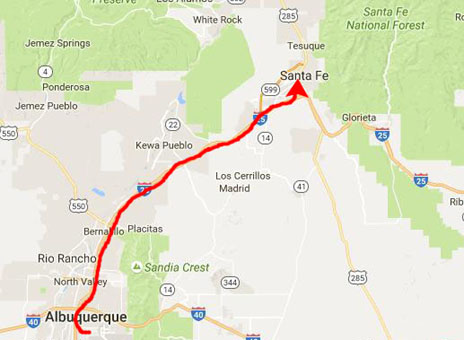 |
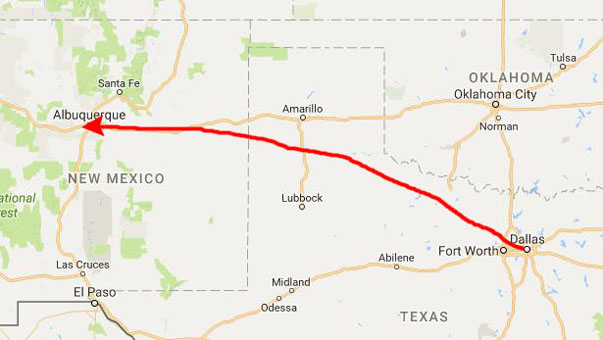 |
Flying to Albuerquerque took just a little over an hour, and the very scenic drive up to Santa Fe just a bit more than that. Greg had already been checked into the El Farolito B&B, so he knew right where to go. The B&B was very conveniently located just about five blocks from the center of Old Santa Fe, where the Cathedral and parks are located. It was also about three blocks from the New Mexico State Capitol.
|
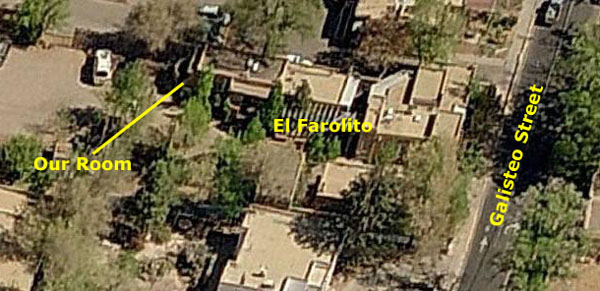 |
There was a main, three-story building in front that had some hotel-like rooms, and then a wing extending out to the back with two-story and single-story rooms and suites. El Farolito had, apparently, also expanded across the driveway to the south, and added more rooms in the buildings on that side of the drive. Greg, thoughtful as ever, had asked the innkeeper to set aside some breakfast for us, even though it was after the time it is usually served, and so we sat on the patio to enjoy it. Greg had actually been staying there for the past two days, and had made friends with the owners (as he usually does), which is how they still had breakfast for us.
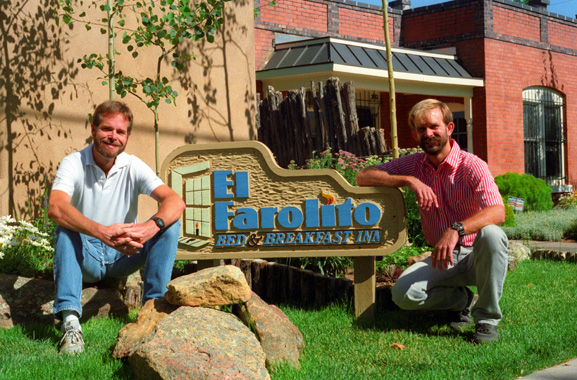 Fred and I in Front of El Farolito The bed and breakfast was quite nice, although expensive by my standards. Fred and I had a large room with a good-sized bath in a small detached building back behind the main building we are in front of here. |
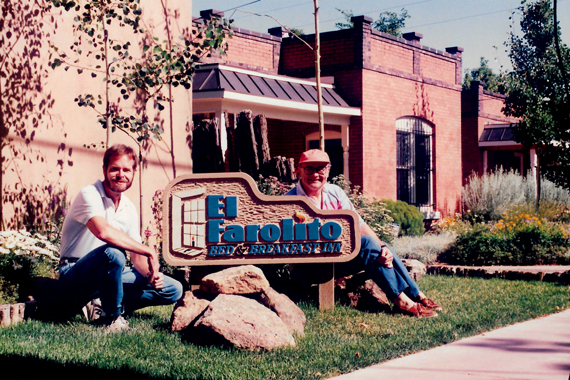 Greg and I in Front of El Farolito The floors were all done in Spanish tile, and all the colors and decorating were done in "Santa Fe style." This means very much a Southwestern look. All in all it was a nice room, but the main attraction was that it was right in the center of town- you could walk to everything. |
Old Santa Fe
|
The earliest known settlement in what today is downtown Santa Fe came sometime after 900; a Native American group built a cluster of homes that centered around the site of today's Plaza Park and spread for half a mile to the south and west- about to where El Farolito is today. The Santa Fe River offered water and transportation. Climate has changed since then; the Santa Fe River no longer flows year-round; indeed, it is the most endangered river in the country.
Don Juan de Oñate led the first European effort to colonize the region in 1598, establishing a pueblo north of present-day Santa Fe. It was New Mexico province's second Spanish governor, Don Pedro de Peralta, who founded what would become modern-day Santa Fe at the foot of the Sangre de Cristo Mountains in 1607; in 1610, he designated it as the capital of the province.
In 1680, the native Pueblo people drove the Spaniards out of the area, but they reconquered it 12 years later, and it remained in Spanish control until the Mexican War of Independence in 1810. The town developed close ties with St. Louis, Missouri, when the Chouteau brothers gained a monopoly on the fur trade, ahead of the Louisiana Purchase of 1803. The 1824 Mexican Constitution cemented the city's status as the capital of New Mexico. That was the situation as it stood at the outbreak of the Mexican-American War in 1846.
As we walked towards the center of town, we could see that almost all the stores were either selling something artistic, or they were dealing in goods with a decidedly Spanish or Southwestern flair. Santa Fe is a mecca for artistic types of all kinds; there are a number of famous people in the arts that have homes here, and there is a thriving collection of art galleries and stores of all types. The city is home to the Georgia O' Keeffe museum right downtown.
|
|
The architecture in Santa Fe is a mixture of Spanish and Western influences. One can see indications of classical Spanish architecture (actually Moorish, as evidenced by the arched doorway in the building at the far right), but also the evidence that this was a building that could have occupied space in a frontier town (mostly evidenced by the materials used for construction). I had no way of telling how old this building actually was, however, and that is part of the charm of the "Santa Fe style." All of the pots and desert flowers give a pleasing appearance to the building.
|
A day later, we happened to be out walking again when we noticed what we thought were workmen repairing a building, but what they were actually doing was "re-mudding" an adobe facade- exactly the kind of maintenance I mentioned above. (Because of this, many more recent buildings use appropriately-colored stucco, which lasts a lot longer.)
This prompted me to investigate Santa Fe architecture. The Spanish laid out the city according to the "Laws of the Indies", town planning rules and ordinances which had been established in 1573 by King Philip II. The fundamental principle was that the town be laid out around a central plaza. On its north side was the Palace of the Governors, while on the east was the church that later became the Cathedral Basilica of Saint Francis of Assisi.
As the city grew throughout the 19th century, the building styles evolved too, so that by statehood in 1912, the eclectic nature of the buildings caused it to look like "Anywhere USA". The city government realized that the economic decline, which had started more than twenty years before with the railway moving west and the federal government closing down Fort Marcy, might be reversed by the promotion of tourism.
To achieve that goal, the city created the idea of imposing a unified building style – the Spanish Pueblo Revival look, which was based on work done restoring the Palace of the Governors. The sources for this style came from the many defining features of local architecture: vigas (rough, exposed beams that extrude through supporting walls, and are thus visible outside as well as inside the building) and canales (rain spouts cut into short parapet walls around flat roofs), features borrowed from many old adobe homes and churches built many years before and found in the Pueblos, along with the earth-toned look (reproduced in stucco) of the old adobe exteriors.
After 1912 this style became official, although broadened after 1930 to include portales (large, covered porches), white-painted window and door pediments, and terra cotta roof tiles. By an ordinance passed in 1957, new and rebuilt buildings, especially those in designated historic districts, must exhibit a Spanish Territorial or Pueblo style of architecture, with flat roofs and other features suggestive of the area's traditional adobe construction. Contemporary houses in the city built from lumber, concrete blocks, and other common building materials, used earth-toned stucco surfaces (disparagingly called "faux-dobe") reflecting the historic style.
|
Listed on the National Register of Historic Places, the Plaza consists of a central park lined with grass, trees, and benches, which add to the cultural scenery, especially at Christmastime when the Plaza streets and buildings glow with farolitos and the occasional luminaria, and trees glow with lights. Included in the park is an American Indian War Memorial monument as well as a performing arts stage. It traces its origins back to the 1700s when the town was settled by conquistadors.
In and around the plaza are historic monuments, restaurants, businesses and art galleries, including the Palace of the Governors (the oldest public building in the U.S.), the New Mexico Museum of Art, the Cathedral Basilica of Saint Francis of Assisi, and the Loretto Chapel. In true pueblo fashion, the architecture used in the immediate area of the plaza is almost exclusively the traditional adobe.is traditional adobe.
|
|
What makes Santa Fe so easy to get around in without a car is, of course, its small size. You can walk from one end of the main shopping district to the other in the space of thirty minutes or so, so a lot of vehicles and the requisite parking isn't necessary. Fred was impressed by the wide variety of flora that had been planted in this interior courtyard.
We thought about going by the Georgia O'Keeffe museum, but opted instead to do more walking around the old part of the city and then perhaps go out to Canyon Road to the arts and crafts area.
|
The cathedral was built by Archbishop Jean Baptiste Lamy between 1869 and 1886 on the site of an older adobe church, La Parroquia (built in 1714–1717). An older church on the same site, built in 1626, was destroyed in the 1680 Pueblo Revolt. The new cathedral was built around La Parroquia, which was dismantled once the new construction was complete. A small chapel on the north side of the cathedral was kept from the old church.
Influenced by the French-born Archbishop Lamy and in dramatic contrast to the surrounding adobe structures, Saint Francis Cathedral was designed in the Romanesque Revival style. As such, the cathedral features characteristic round arches separated by Corinthian columns and truncated square towers. The large rose window in front and those of the Twelve Apostles in the lateral nave windows were imported from Clermont-Ferrand in France.
The towers were originally planned to be topped with dramatic 160-foot steeples, but due to lack of funds, these were never built. The left tower is a single row of bricks taller than the right tower. The cathedral was built from yellow limestone blocks quarried near the present site of Lamy.
The Cathedral of Saint Francis of Assisi would be officially elevated to a basilica by Pope Benedict XVI on October 4, 2005, when it would be named the Cathedral Basilica of Saint Francis of Assisi. I have used the current names to reference it on these pages.
I wanted to get as good a picture of the cathedral as I could, so I waited for there to be as little vehicular traffic in front of it as possible. Obviously, I was less than totally successful.
The city and the surrounding areas have a high concentration of artists. They have come over the decades to capture the natural beauty of the landscape, the flora and the fauna. One of the best known New Mexico–based artists was Georgia O'Keeffe, who lived for a time in Santa Fe, but primarily in Abiquiu, a small village about 50 mi away. The New Mexico Museum of Art and Georgia O'Keeffe Museum own several of her works. O'Keeffe's friend, western nature photographer Eliot Porter, died in Santa Fe.
|
We thought that would be a nice walk for the afternoon, so after we had some lunch, we walked about eight blocks southeast from the cathedral to the foot of Canyon Road, and then walked along it uphill to the east.
|
Canyon Road is a winding road that parallels a small stream about a half mile from the center of the old city. It was like walking along a country road, rather than being in the middle of a city. The galleries were for the most part in what had been private homes at one time.
In going through these galleries, each of us found artwork that he would like to have. Greg, in fact, was looking to purchase another work by an artist whose earlier work he already had some of, but found that the pictures he wanted were far too expensive, the artist having been "discovered".
Fred found a number of pieces of Western art that he liked, and I found some paintings that I liked also. None of us bought anything major though; we were just looking. I did see one large picture that reminded me of the kind of paintings my sister did, and I saw that the price was over $60,000. I made a mental note to tell Judy about that; I thought her pictures of horses were much better, and if there is that much money to be made in painting, I thought, she should get back into it. This gallery was a particularly nice one.
Since Fred's birthday is in August, I bought him a print that he had been admiring without his knowing.
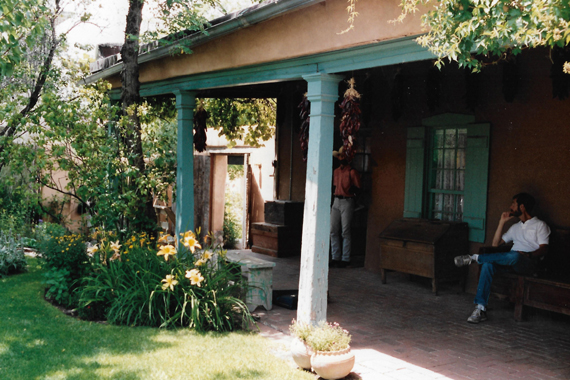 On the Porch of an Art Gallery While Greg was looking into some prints by an artist he liked, I took the opportunity to rest for a minute on the porch. Greg came out and took this picture of Fred and myself. |
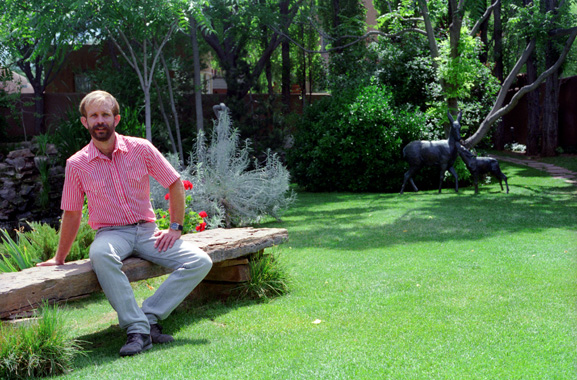 Fred in the Sculpture Garden of One Art Gallery Later in the afternoon, on the way back to the hotel, we passed a very large gallery that specialized in outdoor bronze sculptures, like the ones that occupy the Allied Bank plaza here in Dallas. They displayed these sculptures in an outside garden. This is part of that garden. |
Elsewhere in the garden, the artist has captured the way a human figure would look in everyday postures, such as leaning against a post or a building wall. The details of the clothes and jewelry were also quite good. Each of these sculptures was in the range $5000 to $15000; some were quite elaborate and consisted of multiple separate figures.
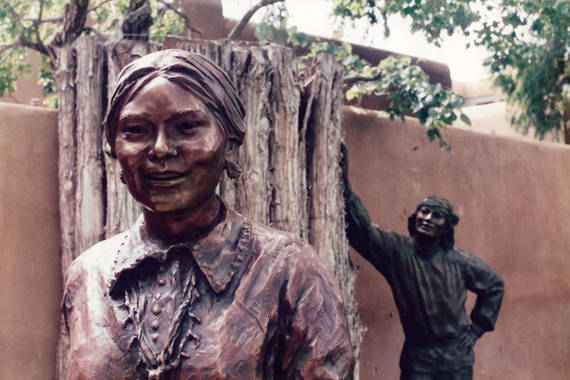 Two of the Bronze Sculptures in the Garden Some of the sculptures are very realistic. Oh, no one is going to think that the people are real, but when you look at them quickly, the poses that they are in seem to be entirely natural. |
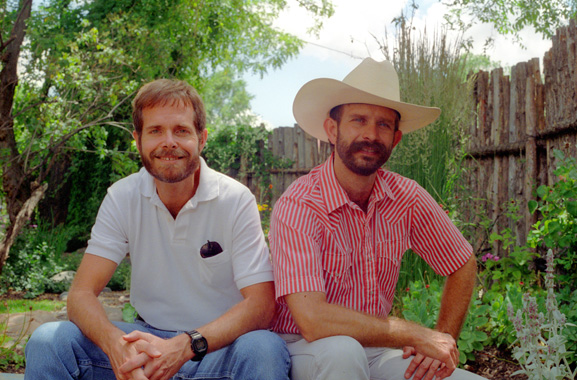 Fred and I in the Sculpture Garden I had Greg take this picture, and it has turned out to be one of my favorites. |
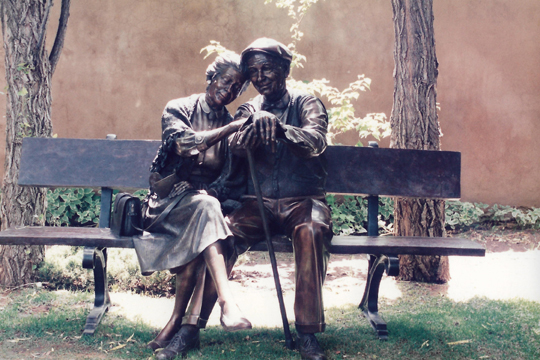 Two More Figures in the Sculpture Garden Now these figures are even more reminiscent of the figures in downtown Dallas, and I wonder if the people who put them here actually got them from this artist. |
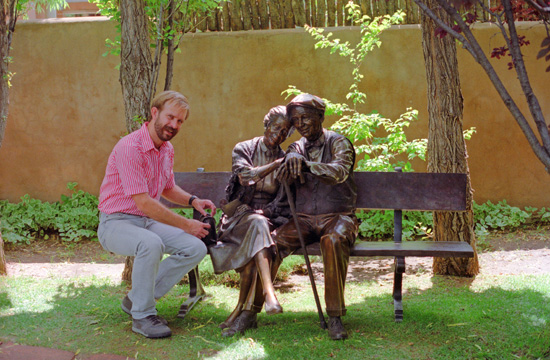 Another Picture from the Sculpture Garden Even Fred is fooled as he goes through the bronze purse of the sculptured lady. Obviously, I just wanted this picture for fun. |
In one of the galleries, Greg spotted a picture that he enjoyed very much, and I think that if his finances had been a good deal better, he might well have purchased it. It's a fun piece, but might not be everybody's cup of tea. Greg and Fred had read that this particular artist specialized in nude males in a Western setting (a gay artist, I think) was having a show at this gallery, but it was closed until Monday. I took a picture through the glass window in the door of the gallery. Greg went back there on Tuesday, and told us later that the pictures were not as good as we might have thought. Nude cowboys had certainly piqued Fred's interest and mine. You can have a look at the picture that I photographed here.
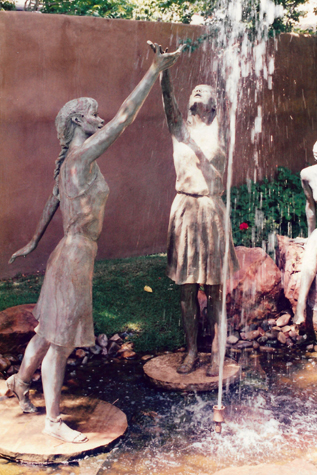 |
(Picture at left) Here are some more bronze figures in the sculpture garden. All three of these figures and the fountain itself form a single work. The price for the group was $30,000.
(Picture at right)
|
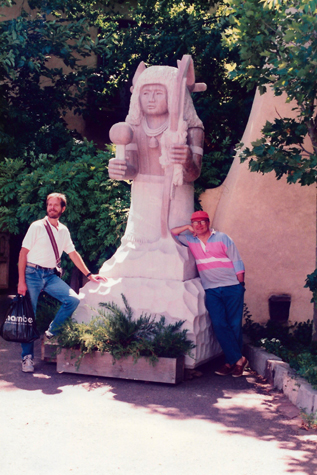 |
Dinner With Some Friends of Greg's
|
So while Mary stayed at the house, Chris drove the three of us out to the land, on which we then spent some time walking around. The land was situated on a hilltop, and was just raw acreage. It was very rough, and much effort would have to be expended to form a decent site for building. For one thing, a driveway (actually, a road) would have to be built from the nearest city street up to the top of the hill where the house would be.
In addition to the road, it would be very expensive to bring water, sewer (since the land was inside the city limits) and electric to the site. We talked about all this, and while we all agreed it would be an outstanding site for a house, the project might be more work and expense than Greg would want to take on. But the view across the valley from the site was certainly pretty amazing, as you can see at left and if you click here.
But it was fun to walk the land and see how serious Greg might be about. We thought we'd all agreed that the project would be simply too expensive and too time-consuming for Greg to handle. (As it turned out, we were wrong. Greg did indeed buy the land and have plans drawn for the house of his dreams, but it did turn out that the project was simply too complex, and Greg eventually ended up selling the property to someone else- fortunately losing nothing on the transaction.)
When we finished looking at the land, we returned to pick up Mary and the five of us went to a nearby Mexican restaurant for dinner. After that, Greg, Fred and I went back to El Farolito, and made plans to go out to the local gay bar for a while. The bar was on the top floor of a small office building on the outskirts of the downtown area of Santa Fe. We went ahead and paid the cover charge, something we weren't used to, and went in. The crowd was mostly very young, and the music was very loud. We spent about an hour outside on the patio, the only place where you could hear yourself think. Neither Fred nor I saw anyone of interest, and the three of us went back to El Farolito fairly early.
You can use the links below to continue to another photo album page for our New Mexico Trip or return to the Index for that trip.
 |
July 12, 1992: Taos and the Rio Grande Gorge |
 |
Return to the Index for the Santa Fe Trip |